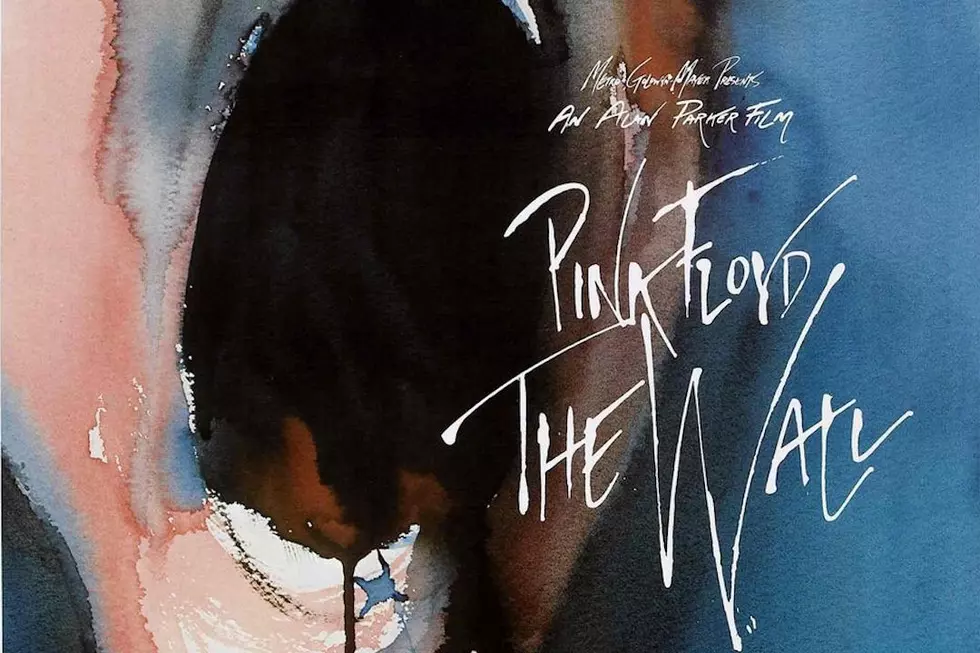
How Metallica Changed the World With Their Most Polarizing Album
The release of Metallica's classic Black Album opened up a wave of debates from the moment it arrived on Aug. 12, 1991. Thirty years later, as the band prepares to celebrate the album with an expanded box set and a wealth of additional tributes, writer Ben Apatoff is taking a fresh look at its history.
Metallica: The $24.95 Book, available Aug. 15, goes deeper than previous tomes on the group, offering a well-researched and compelling overview of Metallica's journey, threading together their story as a series of events and topics, rather than telling it chronologically.
In the exclusive excerpt below, which has been adapted for UCR, Apatoff examines why the Black Album remains Metallica's most popular record and considers its impact on pop culture, and how it changed both music and surrounding areas forever.
Most people have a basic idea of Nielsen SoundScan, which started tracking music sales weekly in 1991. It’s the largest source of record sales figures, displacing Billboard’s method of calling up stores for guesstimates.
But ask the average music fan about the highest-selling record since the '90s and you’ll get a slew of answers, ranging from Alanis Morissette’s Jagged Little Pill to Shania Twain’s Come on Over to whichever boy band left the biggest dent in their consciousness. You usually won’t get the correct answer, which is Metallica’s Black Album.
Why is this? Are Metallica underrated? Is their impact so ubiquitous that it’s taken for granted?
We’re living in the world Metallica revolutionized, and there’s no greater example of Metallica demolishing and rewriting norms than the Black Album. Few recordings are both as canonized and as controversial. It’s Metallica’s star-making turn, getting weirder and catchier in the same songs, the moment where people who took pride in enjoying aggressive music were mortified and the rest of the world wondered what it had been missing in the past eight years.
By 1990 James [Hetfield] and Lars [Ulrich] were discussing writing shorter, simpler songs for their next record, with the Misfits, the Rolling Stones, and AC/DC in mind. (Ulrich in 2020: “The two most underrated drummers in rock, to me, are the Rolling Stones’ Charlie Watts and AC/DC’s Phil Rudd. ... In terms of ‘air-drumming moments,’ you know, there are so many incredible ones from both of those guys.”) Ulrich's AC/DC obsession led to him listening to them every day around the Black Album’s recording, distinguishing his own band against another whose best-known record had an all-black cover. AC/DC and Metallica are forever linked as the two bands on Beavis and Butt-Head’s shirts, as well as being the two biggest artists to never release a greatest hits album, but that influence would show up clearest in the Black Album.
Producer/engineer Bob Rock was not a Metallica fan. He had famously worked on Bon Jovi’s Slippery When Wet, the Cult’s Sonic Temple and Motley Crue’s Dr. Feelgood, and was initially more interested in producing his friend Richie Sambora’s upcoming solo record (in a 1989 Rolling Stone interview, Sambora defended his band by protesting, “I’m not here to make the guy in Metallica happy.”) Recording with Rock in Los Angeles’ One on One studios, Metallica met glam metal in its home territory but found a more direct adversary in the studio.
The producer did not get starstruck, and dragged Metallica into upward of 40 takes for each song, recording songs live in the studio in hopes of bringing Metallica’s wild stage energy to the record. Hetfield fought with Rock to the point where the producer named him “Dr. No,” and by the end of the record, Ulrich and Rock weren’t on speaking terms. (Being Metallica, they still invited him back to produce their records for the next 12 years). “I could never make them do anything they didn’t want to do,” Rock stated in David Masciotra’s Metallica 33 1/3 book. “I just tried to help them make the best record they could make.”
Purists love complaining that Rock turned Metallica into a radio-friendly band. Older fans say the '80s records were better, and younger listeners can’t imagine a world where mainstream rock sounds nothing like the Black Album. But Metallica made violent, imaginative music for Rock’s production, giving his sonics and engineering a frightening new soundscape that brought out the most in his skills. Metallica didn’t need songs like “Nothing Else Matters” for success; they already were one of the world’s most popular metal bands. The songs were written pre-production, but Bob built up the performances by provoking Metallica into different keys, lyrics, solos and drum fills, subverting ... And Justice for All with Metallica’s heaviest bass sound to date, and rhythms written with Kirk [Hammett] and Jason [Newsted].
Watch Metallica's 'Nothing Else Matters' Video
Metallica were breaking out of themselves on the Black Album. They’d created a formula — a fast, heavy opener with a quiet intro (“Fight Fire With Fire,” “Battery,” “Blackened”) leading into a title track epic (“Ride the Lightning,” “Master of Puppets,” “... And Justice for All”) before slowing into a powerful groove (“For Whom the Bell Tolls,” “The Thing That Should Not Be,” “Eye of the Beholder”), reinventing the ballad in thrash form (“Fade to Black,” “Welcome Home [Sanitarium],” “One”) with at least one instrumental or spoken word near the end (“The Call of Ktulu,” “Orion,” “To Live Is to Die”) — until the Black Album’s focus on vocals (the penultimate track “My Friend of Misery," written around a bass line from Newsted’s demos, was originally to be the record’s instrumental).
After their biggest, most constructed show yet with the Doris statue on the Damaged Justice tour, Metallica were now performing without so much as a backdrop. On their first four records, Ulrich wanted show off Metallica’s compositional chops by printing each song length on the back, but did no such thing on the Black Album. Metallica weren’t giving hints on the record sleeve anymore. After creating four of the most recognized and referenced metal images on the covers of Kill ’Em All, Ride the Lightning, Master of Puppets and ... And Justice for All, Metallica stripped themselves of imagery with an all-black cover. Like everything Metallica, a closer look shows something different, and we can see Metallica’s name and a snake faded into the black. People who notice the snake often assume it’s the Gadsden flag rattlesnake, with its coiled, striking position (and because the Black Album has a song called “Don’t Tread on Me”). But a closer look reveals the supposed Gadsden snake is stripped of its rattle. Metallica remove the snake’s identity, just as they shed their own on the Black Album.
Blackness is a theme, in darkness (“Enter Sandman,” “Sad but True,” “The Unforgiven,” “My Friend of Misery,” “The Struggle Within”) and in emptiness (“Through the Never,” “The God That Failed”), the deepest dive yet into a color as ubiquitous in metal as “blue” is in jazz (Black Sabbath, Back in Black, black metal, for starters). There’s barely any cover art or an official title, removing Metallica from the reputation they created for themselves. Technically the album is called Metallica. Eponymous records usually suggest a first album, and here in Metallica’s rebirth it still kind of is. The Black Album is millions of fans’ first Metallica record and first metal record. It’s also appropriate for such a deeply Metallica record to be named for themselves, even if nobody calls it Metallica any more than they’d call the White Album “The Beatles.” The album’s most popular name isn’t its official title but what the fans call it. Like Sergio Leone’s Man With No Name in Hetfield’s favorite film, The Good, the Bad and the Ugly, Metallica left the title blank so you could use your own.
Watch Metallica's 'Enter Sandman' Video
The titles and cover art are audacious homages to three well-known precursors. Metallica honor the Beatles and invert them, claiming their place as the biggest band in rock on their own terms, living impervious to trends and creating new ones. There’s Metallica’s fascination with Back in Black, a straightforward reinvention of rock music loaded with hits. Metallica responded to the biggest hard-rock record of all time with the biggest metal record of all time.
Somehow, the Black Album manages to reflect both the Beatles’ sprawl over an array of moods and ideas and the succinct AC/DC over 12 forthright songs, three songs more than ... And Justice for All and still three minutes shorter. Finally, the Black Album is the brethren of Spinal Tap’s all-black Smell the Glove cover in This Is Spinal Tap. (Metallica eventually met Spinal Tap while supporting the Black Album, in an entertaining scene captured in A Year and a Half in the Life of Metallica. An indignant David St. Hubbins is not impressed that another band has released an album with an all-black cover: “Where did that idea come from?”)
Many songs, like “Sad but True,” were based on vocal lines, on the first Metallica record where the vocals were as high in the mix as the guitars and drums. Hetfield blew out his voice in the studio, developing vocal cord nodes recording the B-side Anti-Nowhere League cover “So What” and eventually took singing lessons from a cantor, which resulted in his more forceful and melodic tone on the album. Hetfield took vocal cues from Chris Isaak songs, and worked with Rock to double and build the vocals in the mix, apt for a record where he was embodying multiple characters, sometimes in the same song, switching narrators in “Enter Sandman” or species in “Of Wolf and Man.”
The situations were getting vaguer and connecting with broader audiences. “I” started showing up in Metallica’s lyrics more and staying. Hetfield's characters weren’t getting strapped to an electric chair or chopping their breakfast on a mirror anymore, but the anger, aggression and fear were stronger than ever in the whipping boys and scapegoats that reached millions.
Listen to Metallica's 'Of Wolf and Man'
Having redefined the ballad in thrash form on earlier songs like “Fade to Black,” “Welcome Home (Sanitarium)” and “One,” Metallica reinvented themselves further on “The Unforgiven” and “Nothing Else Matters,” dealing angry, heavy verses with a softer, despondent chorus in the former and writing the go-to metalhead wedding song in the latter, taking down hard rock’s macho posturing. Not that Metallica were slowing down—“Holier Than Thou,” “Through the Never” and “The Struggle Within” are among Metallica’s fastest, although Ulrich's mid-tempo drumming on the Black Album songs gave them a swing their thrashier songs lacked.
On “Holier Than Thou,” which Rock wanted to be the first single, Metallica employ their first-ever talk box, although the effect is far removed from the celebratory hooks it gave “Kickstart My Heart” and “Livin’ on a Prayer,” forcing out a blare that sounds more like a chicken getting strangled under the heavy riffs and drumming as Metallica conquer radio metal on their own turf, infiltrating the system to change it in their own name. “Through the Never” kicks off the Black Album’s Side B in a furor, armed with lyrics that paraphrase both Carl Sagan’s Cosmos: A Personal Voyage and Jimi Hendrix’s "Are You Experienced." “Who we are, ask forever,” Hetfield bellows, coming closer to elucidating his band than any number of rock critics. Metallica ask forever, examining themselves, constantly changing as a result.
Like the Beatles and Led Zeppelin five or so records into their career, Metallica tinged their sound with the influence of Middle Eastern music (“Sad but True,” the first demo given to Bob Rock, was originally slowed down in the vein of Zeppelin’s “Kashmir”). “Wherever I May Roam” is “Invictus” as a headbanger, maybe the most Metallica-worthy song on the Black Album by being the most different. Enlisting an electric sitar sound and a 12-string bass proved that changing their music without conforming to anyone’s standards would only make them bigger, complementing the lyrics with music every bit as adventurous as the story.
Watch Metallica Perform 'Wherever I May Roam'
The Black Album is Metallica’s most cinematic release, echoing Ennio Morricone’s “The Showdown” in “The Unforgiven” and quoting measures from West Side Story’s “America” in “Don’t Tread on Me.” Hetfield has said that “Sad but True” was written with the 1978 Anthony Hopkins horror thriller Magic in mind and that “Of Wolf and Man” was inspired by the 1981 werewolf tale Wolfen.
Like their influences, Metallica were shapeshifting from the familiar into something new, taking metal, mainstream rock and legions of new fans with them. This was matched with some of Metallica’s most openly personal music to date. Hetfield recounts his mother's cancer-ravaged faith in the harrowing “The God That Failed” and named “The Unforgiven” as his most personal song in the 2010 documentary Absent. His anguish is met by his bandmates, three of whom (Hammett, Ulrich and Newsted) went through divorces during the Black Album’s recording sessions. “I was trying to take those feelings of guilt and failure and channel them into the music, to get something positive out of it,” said Hammett, describing himself as “an emotional wreck” during the recording process. “Jason and Lars were, too, and I think that has a lot to do with why the Black Album sounds the way it does.”
Hammett stepped up with the immortal “Enter Sandman” main riff, the haunting “Of Wolf and Man” progression (developed by Hammett, adapting his own vocal melodies for guitar) and some of his best-ever solos, perhaps most famously the blistering, percussive passage in “The Unforgiven,” which Hammett would later recall as his most satisfying performance.
On the Black Album, Metallica rebelled against the rebels. Like folk enthusiasts hearing [Bob] Dylan go electric on Bringing It All Back Home, much of the metal community rejected the Black Album as a sellout, horrified that their underground metal heroes had gone for the airwaves (Slayer’s Dave Lombardo claimed to have thrown his copy out). Also like Dylan, Metallica brought it back home on the Black Album, jumping over their NWOBHM influences into stadiums, with a sound that paved the way for Pantera’s “Pure Against the Grain American Metal,” Lamb of God’s New American Gospel and an entire '90s-'00s genre often called the NWOAHM, crafting metal that celebrated and raged against the United States the way previous metal bands examined hell.
It’s a heavy, strange album that puts metal in the mainstream without watering it down. “I think most of our real fans know that we want to play many different styles of music, and that’s something that we started doing on the Ride the Lightning album,” said Ulrich, modestly avoiding the fact that his band was already doing this on Kill ’Em All.
The Black Album is a psychologically diverse record that can soundtrack an individual’s darkest, most emotionally wrecked moments as well as it blasts Yankee Stadium for Mariano Rivera’s walk-up music or serves as Rachel Maddow’s ringtone. Hetfield has said that he wanted the songs to be both “more inward and more universal,” and the result is a permanent puzzle, intriguing without being exhausting, which is part of why it’s been the gateway metal record for countless listeners ever since its release.
To this day the Black Album still sells four to five thousand records a week, with more weeks on the Billboard 200 than any studio album except [Pink Floyd's] The Dark Side of the Moon. But more than its sales, what makes the Black Album one of the most important albums ever is the release it gives its fans, something for alienated listeners to feed their demons to on a greater scale than any other metal record while still feeling personal.
“I remember in 1991 all of these homeless kids in L.A., their anthem was Metallica’s ‘Enter Sandman,’” A Brief History of Seven Killings author Marlon James said in 2015. “And when asked, ‘That’s a song about a kid being killed in his sleep. Your life is so horrible. Why would you like this song?’ They would say there is a warmth in coming across something darker than what you live in and there’s a kind of thrill in knowing that there’s an outcome that’s even darker than yours.”
Music critics often credit [Nirvana's] Nevermind for breaking subversive music onto the charts, banishing glam metal to CD-store bargain bins and county fairs in the process. But Metallica, whose barn burner dropped a month before Nevermind, obliterated the barrier between metal and mainstream, as seen in the subsequent first-ever Billboard Top 10 debuts of Megadeth (No. 2, 1992), Nine Inch Nails (No. 7, 1992), Anthrax (No. 7, 1993), Pantera (No. 1, 1994), Slayer (No. 8, 1994), White Zombie (No. 6, 1995), Rage Against the Machine (No. 1, 1996), Tool (No. 2, 1996), Marilyn Manson (No. 3, 1996) and Korn (No. 3, 1996). Thrashers Testament, Exodus and Kreator all released hard rock–based metal records in 1992, on the heels of the Black Album. More than any other band, Metallica changed what hit metal records sounded like.
Connecting the Black Album once more to the AC/DC record that inspired it, Ulrich grasped where the record stood in Metallica’s context: “You have a record like Back in Black. You have a record like Synchronicity [by the Police]. You have a record like Nevermind. Or you have a record like the Black Album. But you don’t have more than one like that.”
Metallica Albums Ranked
More From Sasquatch 92.1 FM










